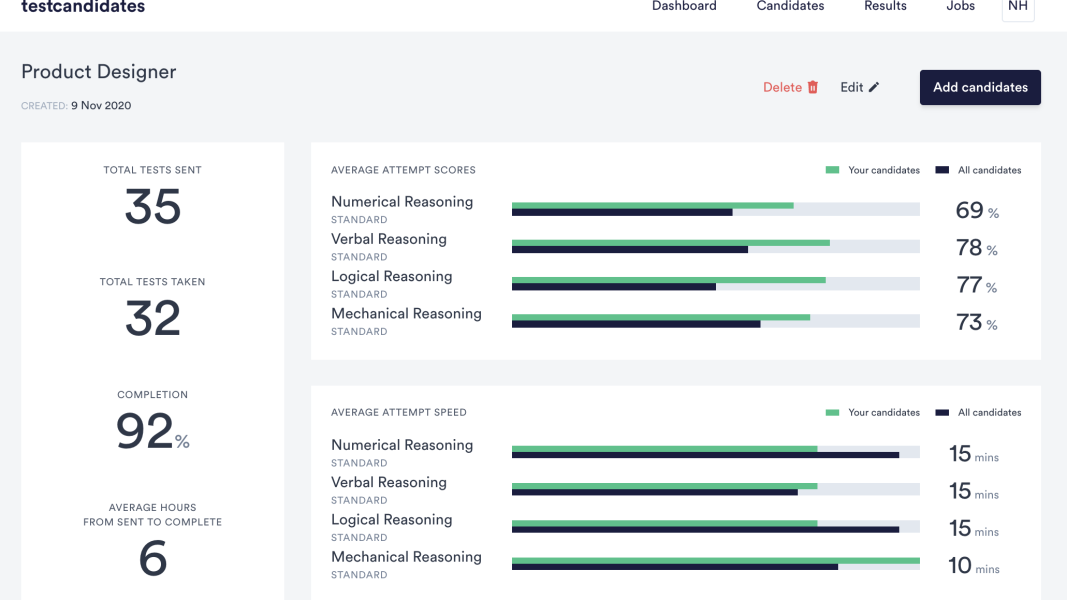The popularity of pre-employment testing is increasing, with employers trusting the wide range of standardised tests on offer to ensure that hiring decisions are data-driven and result in the recruitment of top talent.
In a competitive job market, the number of applications received for an open position can be vast, presenting the challenge of how best to screen, test, and filter potential employees. Recruitment teams must consider how to balance key performance indicators (KPIs) such as the time to hire, quality of hire, adverse impact, candidate satisfaction, and cost per hire.
Improving efficiency and effectiveness, different pre-employment recruitment tests reduce the costs of talent acquisition whilst increasing the quality of your hire – leading to better employee performance and a higher retention rate, all for a lower cost.
What Are Pre-Employment Tests?
Pre-employment tests are standardised psychometric assessments employed during the recruitment process. They may be used for immediate screening post application submission or form part of a later-stage assessment centre.
The tests can provide insight into a candidate’s mental capabilities, ability to work rapidly and accurately under pressure, critical thinking and problem-solving abilities, and behavioural traits, which cannot be appropriately gleaned from a CV or covering letter.
The tests may be based on ability, such as:
Numerical reasoning – Tests that assess a candidate’s ability to deal with numerical data, often presented in graphs, charts, and tables.
Verbal reasoning – A test that gives insight into a candidate’s skill when reading, understanding, and interpreting written information.
Logical/spatial/diagrammatic/abstract reasoning – Tests exploring how well a prospective employee can make deductions from a series of shapes, figures, or patterns, assessing problem-solving and critical thinking.
Mechanical reasoning – A more industry-specific test (along with others such as electrical reasoning) that assesses technical knowledge through operational diagrams.
Pre-employment tests may instead assess a candidate’s behaviours and personality, to judge suitability for the role:
Situational judgement test (SJT) – A test that provides insight into how a candidate would respond in a series of hypothetical workplace scenarios. Used to assess alignment to company culture, values, and ways of working.
Personality questionnaire – To explore a potential employee’s character, motivations, and personality traits. Assesses fit within the company and suitability for the responsibilities of the role.
These tests are usually administered as a set, with employers choosing a selection of tests to best suit their recruitment needs.
There are many different publishers of pre-employment tests, with the format, structure, and content of the tests – for example, question style, time limit, and difficulty – varying according to the publisher.
Some pre-employment tests can be tailored to better suit an employer’s needs, such as building in company culture, values, or specific knowledge areas, creating a custom recruitment journey.
What Are the Costs Involved in Recruitment?
Cost per hire – the average cost to hire a new employee - is a key recruitment KPI. It ensures your recruitment strategy is operating on a budget and proving a good investment.
Recruitment costs are incurred throughout the hiring process, and they should be carefully tracked, reviewed, and optimised. Recruitment has both internal and external costs, so the overall cost is calculated by determining both your internal and external expenses and dividing them by the total number of hires.
Investing in the right places, such as in pre-employment testing, can create a more effective recruitment process, reducing costs.
The costs involved in recruitment include:
Internal
- Organisational costs
- Internal recruiter costs – recruiters’ salaries and expenses
- Referral programme costs
- Candidate travel reimbursements
- New hire training costs
External
- Online vacancy advertising costs (i.e. job board fees)
- Recruitment events (i.e. university campus recruiting days and careers fairs)
- External recruiter expenses (i.e. recruitment agency or staffing firm fees)
- Candidate assessment costs (to companies that provide pre-employment testing and video interview platforms)
- Applicant Tracking System (ATS) costs
- Background checks (if applicable)
Other, harder to quantify, costs of recruitment are also important to consider, such as the impact a vacant position has upon overall productivity.
Cost-Benefits of Pre-Employment Testing
Many organisations face challenges around optimising their recruitment process. Often time to hire is too long, causing workstream delays and impacting productivity. Sometimes, the recruitment process is simply failing to place the right talent into vacant roles, leading to dissatisfaction, disruption of timelines, and, ultimately, a costly reprise of the entire process.
Investing in pre-employment testing can help you to fix these issues, providing a more efficient and effective recruitment process benefits – in terms of both employee suitability and hiring cost.
Reducing Time to Hire
Using psychometric tests in your recruitment process has the potential to drastically reduce your time to hire, as recruitment decisions can be made based upon the data. Narrowing down the applicant pool using CVs and interviews alone can be time-consuming due to their subjective nature and the evaluation needed. Using pre-employment testing to gain a fuller picture of each candidate’s abilities and potential means informed hiring decisions can be made at a faster rate.
Increasing Quality of Hire
Pre-employment tests are trusted indicators of future job performance, providing an objective illustration of skills that CVs and interviews cannot. A successful and effective recruitment process places talented individuals into roles in which they will thrive. Using pre-employment tests will help to ensure candidates have the skills and competencies needed and will be able to excel in the role. This increases employee satisfaction and, subsequently, your staff retention rate.
Improving Employee Retention Rate (and Reducing Turnover Costs)
A greater employee retention rate leads to stability, continuity, and greater productivity within an organisation. Employee changes are disruptive and can delay project progress as well as incur new hiring and training costs. Pre-employment testing can help you to place suitable talent with the right skills, approach, and character to rapidly thrive within the company, avoiding repeated or frequent costs incurred for re-recruitment and initial on-the-job training.
How Much Money Does Pre-Employment Testing Save?
Using pre-employment testing within your recruitment process has the potential to drastically decrease the unnecessary costs associated with a time-consuming and ineffective process.
The size of applicant pools, not lack of talent, is the main reason recruitment processes are taking so long to complete. An overwhelming number of applications means many recruiters find it challenging to manage the flow of applicants and identify the best talent.
Early-stage pre-employment testing can be effectively utilised to screen candidates, ensuring only the top applicants progress to the next stage of the process and reducing the number of phone or in-person interviews that needs to be conducted.
This means they reduce the amount of time spent on recruitment activities such as screening and interviewing, optimising the workload of your recruitment team. With interviews lasting around 40 minutes on average, this has a large impact on time management and can free up a considerable amount of your recruiters’ salaried time. With an hour of staff time often costing upwards of £25, this can accumulate to be a considerable saving across the board.
A more effective recruitment process also avoids any prolonged detrimental impact upon overall company productivity, by placing quality talent into the correct roles at a faster rate.
As future employees are assessed for their skills and competencies and screened with the insights of objective data, they are better suited to their roles, quickly able to take on responsibilities, and perform to a high standard. This results in high pre-employment test-scoring employees being of greater value to the company by the hour and needing less investment in their baseline training.
Filling your vacant roles in an intelligent and targeted manner results in greater employee satisfaction and less chance of new hires leaving within a year. The cost of staff turnover can be great - replacing a mid-level employee can be up to as much as 46% of their annual salary. For a high-level executive, this cost can be a colossal 200% of the annual salary.
Using pre-employment testing not only saves time – and therefore money – during your recruitment process, but it saves on turnover costs. The right person, in the right role, has the potential to increase productivity and innovation, contributing to an uptick in company profits.









